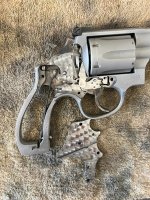Has anyone seen this before? Looks old school. Anyone familiar with these modifications or if they were of any practical benefit? Kinda cool looking. I haven’t had a chance to measure the trigger pull, but it sure is smooth.
Thanks
Thanks
Attachments
Last edited:


